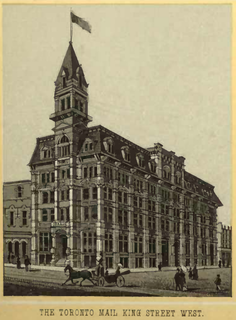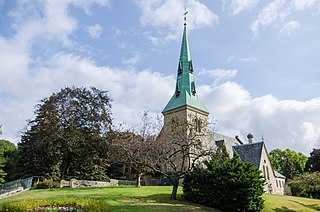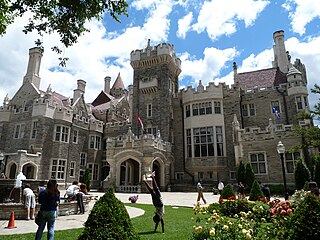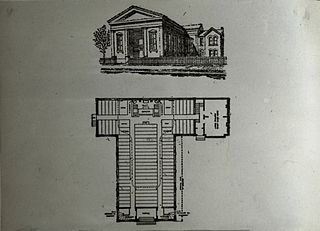
The Welland Canal is a ship canal in Ontario, Canada, connecting Lake Ontario and Lake Erie. It forms a key section of the St. Lawrence Seaway and Great Lakes Waterway. Traversing the Niagara Peninsula from Port Weller in St. Catharines to Port Colborne, it enables ships to ascend and descend the Niagara Escarpment and bypass Niagara Falls. It is the fourth canal connecting these waterways; three smaller predecessors also bore the same name.

Bradford is the primary country urban area of the Town of Bradford West Gwillimbury, Ontario, in Canada. It overlooks a farming community, known as The Holland Marsh, located on the Holland River that flows into Lake Simcoe.

Edward James Lennox was a Toronto-based architect who designed several of the city's most notable landmarks in the late nineteenth and early twentieth centuries, including Old City Hall and Casa Loma. He designed over 70 buildings in the city of Toronto.

The Old City Hall is a Romanesque-style civic building and court house in Toronto, Ontario, Canada. It was the home of the Toronto City Council from 1899 to 1966 and remains one of the city's most prominent structures.
St. James-Bond United Church, at 1066 Avenue Road in Toronto, Ontario, was a United Church of Canada congregation from 1928 to 2005, when it merged with Fairlawn Heights United Church in the Yonge Street and Lawrence Avenue area. The "St. James-Bond" name derived from the merger of St. James Square Presbyterian Church with Bond Street Congregational Church in 1928. Prior to the merger, they were separate congregations downtown, of the Presbyterian and Congregational traditions respectively.

The Board of Trade Building was one of the first skyscrapers in Toronto, Ontario, Canada. Completed in 1892 on the corner of Front Street East and Yonge Street, the seven storey tower was home to the Toronto Board of Trade and the Toronto Transit Commission.

205 Yonge Street was formerly a four-story Bank of Toronto building built in 1905 in Toronto, Ontario, Canada. It was designated under the Ontario Heritage Act in 1975. The E. J. Lennox-designed structure has a domed roof and Corinthian columns on the front, and it is an example of neoclassical architecture.

Colborne Lodge is a historic house museum located in an 1836 home in Toronto's High Park. John George Howard, an architect, engineer and prominent Toronto citizen, built this house, which became the property of the city following his death in 1890.

The Mail Building, later known as the Mail and Empire Building was built in the 1870s and home to the newspaper The Toronto Mail at the northwest corner of Bay Street and King Street West. It was damaged by a serious fire in 1884, but fully repaired. The 4 storey building was topped with a 5-storey spire.
Since its founding in 1829, Upper Canada College (UCC), in Toronto, Ontario, Canada, has occupied a number of sites and various structures on those sites. The school campus has always held a relatively prominent place within the city.

The Toronto Athletic Club, also known as the Stewart Building, is a historic building located at 149 College Street in Toronto, Ontario. It was designed by E. J. Lennox and built in 1894 to support the activities of the club; it included the first indoor pool in Toronto. A similarly named but unaffiliated Toronto Athletic Club now exists in the Toronto-Dominion Centre.

The Beard Building was a seven-storey, 25.38 m (83.3 ft) Richardsonian Romanesque highrise in Toronto, Ontario, Canada that is considered to be Toronto's first skyscraper. Designed by E. J. Lennox and completed in 1894, initial plans were for a nine-storey, iron-framed structure, but a more traditional wood/brick combination with seven storeys was settled upon.

St. James' Cemetery is a historic cemetery in Toronto, Ontario, Canada. It is the oldest cemetery in Toronto that is still in use, having opened in 1844. It was originally the burial ground for the Cathedral Church of St. James, but it later became non-denominational. The main entrance to the cemetery is located at 635 Parliament Street, north of Wellesley Street East. Just to the west is the St. James Town neighbourhood, which is named after the cemetery.
The Queen City Yacht Club (QCYC) is a maritime-themed club based in Toronto, Ontario. It is located on Algonquin Island in the Toronto Islands, and has been a part of Toronto's sailing community since it was founded in 1889. Toronto at the time was known as the "Queen City of the Lake". The original clubhouse was located on the city side of Toronto Harbour, at the foot of York Street.

Casa Loma is a Gothic Revival castle-style mansion and garden in midtown Toronto, Ontario, Canada, that is now a historic house museum and landmark. It was constructed from 1911 to 1914 as a residence for financier Sir Henry Pellatt. The architect was E. J. Lennox, who designed several other city landmarks. Casa Loma sits at an elevation of 140 metres (460 ft) above sea level, 66 metres (217 ft) above Lake Ontario.

Broadway Methodist Tabernacle was a prominent Methodist church in Toronto, Ontario, Canada, that existed from 1872 to 1924. The congregation was originally housed in a wood chapel at the intersection of Spadina Avenue and Dundas Street, which at that time was known as St. Patrick Street. It was originally named the Spadina Avenue Methodist Church. Rapid growth in the congregation saw it seek a new home, and in 1876 a larger lot was purchased at the northeast corner of Spadina and College Street. The wooden church was transported on rollers north to the new location. The old site eventually became the location of the Standard Theatre.
Mechanics' Hall was a concert hall on the ground floor of the Mechanics' Institutes building in Toronto, Ontario, Canada. The hall was used for theatrical productions, music concerts, public meetings, and lectures from 1856 to 1883.

Colborne Street is a street running several hundred metres east of Yonge Street in downtown Toronto, Ontario, Canada. It crosses Victoria Street and Leader Lane, ending at Church Street. It is located between and parallel to King Street East and Wellington Street East. The street is notable for retaining several historic buildings built during the reign of Queen Victoria.

Bond Street Baptist Church built originally in 1848 represented the first permanently established Baptist congregation in the city of Toronto, Canada.

Kodak Mount Dennis Campus, also known as Kodak Heights, was an industrial park in the Mount Dennis neighbourhood of Toronto, Ontario, Canada. It was owned and operated by the Eastman Kodak Company as a major camera manufacturing factory since its opening in 1912, peaking at 900 employees in 1925, 3,000 in the 1970s, falling to about 800 before it ceased the plant's operations in 2006.
















